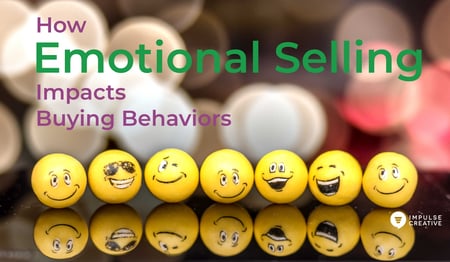Want to get people to buy from you? Get to their subconscious. Get to their emotions.
I hope you immediately said yes, it’s super important to the market success of your products and services.
Why is it important?
Research shows that we consumers buy based on feelings and emotions, and much of it is done without even thinking about it.
Want to learn even more about this topic, join us for the Challenge/Change/Control: Turning Prospects into Revenue by Using Emotions webinar.
Luxury goods target our feelings of self-worth, acceptance, and status in the world.
Have you ever caught yourself keeping up with the Joneses? 😀
Communication devices excite us by offering a connection to friends, family, and a broader network of people. 👬👭
Athletic brands inspire by offering adventure and glory through the act of competition. 🏆
Consumer products from perfume and cologne to lingerie, target emotions related to love, relationships, and sexual desires. 💋😘
Whoa, hey now.

Let’s get back into learning about emotional selling. 😉
And yet, so many sales professionals still try to get us to buy with facts and figures. Especially in the business to business (B2B) space.
Yes. Even B2B sales professionals and marketers can and should use emotion.
Here are a few ways to use emotional selling to impact a potential buyer.
Tap Into Fear for Emotional Selling
The fact is, as buyers we’re compelled to speak to salespeople when something’s not working for us in our daily lives. When a broken process causes us to miss goals or slows career advancement, we’re motivated to make a change.
While you shouldn’t create a false sense of fear or intimidate your buyers into making a purchase, you can still tap into that fear. Find out what they stand to lose if things continue the way they’re going. Then as the conversation progresses, show how your brand will solve those problems. This calms their fear.
FOMO and Emotional Selling
The fear of missing out. We all experience it. This specific subset of fear has become more prevalent in our interconnected, social media world. In business, a prospect doesn’t want to be the one responsible for their company missing out on the next big thing or getting left behind by their competition.

Tap into this emotion by showing them case studies of customers they can see themselves in. You can also give them outside research highlighting the business pain your company solves, proving it isn’t just a trend but a necessity to address. This will bring up that FOMO and increase the likelihood of a close.
Highlight Hope for Emotional Selling
Your prospect is fearful of the status quo. On the other side of that fear is the hope that things will get better. You don’t want to focus on only the negative. In order to close a deal, you have to lead prospects toward their better tomorrow. Give them hope!
You can start this conversation by asking your prospect, “In your perfect world, how would this process work for you? What would your perfect day look like?”
You get to uncover their goals and discover exactly where their biggest pain points lay. Then you paint a picture of a better future.
Build Excitement in Emotional Selling
Excitement leads to a sense of urgency and keeps your prospect engaged in the sales process. If they’re feeling bored or disinterested by your conversations, there’s no incentive to keep speaking with you.

For prospects who get excited by technological innovations, demos keep them engaged. For others, hearing about the new and exciting things they’ll be able to accomplish is the key to driving enthusiasm. It’s your job to figure out what exactly gets your prospect going and then play to that.
Learn the Challenge-Identify-Control Framework in this New Webinar
So how can you add even more emotion to your sales process?
By using a framework like Challenge - Change - Control. Challenge what the customer thinks. Identify an urgency to change. Control the process.
Sign up for this special Sprocket Talk webinar: Challenge/Change/Control: Turning Prospects into Revenue by Using Emotions
Oliver Lopez, CEO and Founder of Structsales, will join George B. Thomas to explore this sales strategy.
With over 20 years of experience, Oliver has been called a speaker in the borderland of marketing and sales, as his ability to generate revenue for his clients is wrapped around the perfect synergy between marketers and sales representatives that strive to increase their profits in complicated B2B environments. You don’t want to miss this event on October 10, 2019.
Emoji photo by Fausto García on Unsplash




